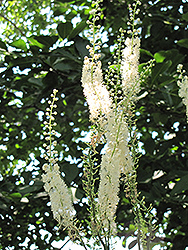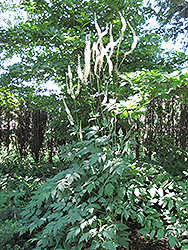Plant Height: 3 feet
Flower Height: 5 feet
Spread: 3 feet
Sunlight:
![]()
![]()
Hardiness Zone: 4
Description:
Great for woodlands and naturalized areas; produces large, attractive green leaves that are finely divided ; flowers are vertical clusters that attract pollinators; keep soil moist with some drainage
Ornamental Features
Mountain Bugbane features showy clusters of lightly-scented white flowers rising above the foliage in early fall. Its serrated compound leaves remain green in color throughout the season.
Landscape Attributes
Mountain Bugbane is an herbaceous perennial with an upright spreading habit of growth. Its medium texture blends into the garden, but can always be balanced by a couple of finer or coarser plants for an effective composition.
This is a relatively low maintenance plant, and is best cleaned up in early spring before it resumes active growth for the season. It is a good choice for attracting birds and bees to your yard. It has no significant negative characteristics.
Mountain Bugbane is recommended for the following landscape applications;
- Mass Planting
- Border Edging
- General Garden Use
- Groundcover
- Naturalizing And Woodland Gardens
Planting & Growing
Mountain Bugbane will grow to be about 3 feet tall at maturity extending to 5 feet tall with the flowers, with a spread of 3 feet. Its foliage tends to remain dense right to the ground, not requiring facer plants in front. It grows at a medium rate, and under ideal conditions can be expected to live for approximately 10 years. As an herbaceous perennial, this plant will usually die back to the crown each winter, and will regrow from the base each spring. Be careful not to disturb the crown in late winter when it may not be readily seen!
This plant does best in partial shade to shade. It prefers to grow in average to moist conditions, and shouldn't be allowed to dry out. It is particular about its soil conditions, with a strong preference for rich, acidic soils. It is somewhat tolerant of urban pollution. This species is native to parts of North America. It can be propagated by division.

